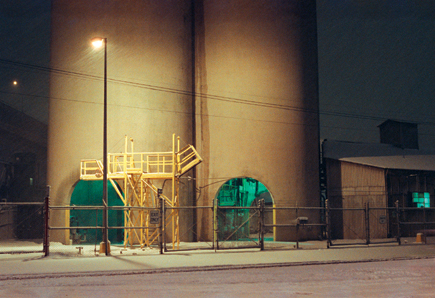Epson’s Stylus Photo 1400; A New Dye-Ink Printer That Replaces The 1280 Page 2
 |
|
|
Before getting the Epson Stylus Photo 1400 to test I was sent a sample of
an entirely new type of paper, which I first tried with my pigment-ink printers.
It is Ink Press Paper's Fiber Gloss (www.inkpresspaper.com/inner/profiles.asp?PaperID=37),
which they describe as "a smooth high gloss surface, single-sided paper.
Its quick-dry microporous coating offers high opacity and brightness and it's
optimized for pigmented or dye inks. Being a fiber-based paper, it absorbs inks
in the paper better than any RC papers, and gives beautiful deep colors to the
image." This new paper responded well to printing with my pigment-ink
printers, but I had a hunch it might do even better with the new Epson Stylus
Photo 1400's Claria dye inks.
After profiling this Ink Press Fiber Gloss paper for use with the 1400, just
printing my standard test image indicated my hunch was correct. So I made a
large set of test prints with many different kinds of subjects and image styles.
The results were consistently good and produced print images that were both
brilliant and more open, revealing better image information in mid to darker
tones than any glossy or luster papers of the past. Apparently the fiber-based
substrate of Ink Press' Fiber Gloss is of significant advantage when using
dye-ink photo printing.
On the other hand, I tried using one of the recently new fiber-based luster
finish papers that have generated a lot of favorable response from users of
pigment-ink printers. Possibly these new fiber luster papers were specifically
formulated to support pigment ink only, because the one I tested did not produce
prints in any way superior to the same image reproduced on an RC-based luster
paper.
 |
|
|
Evaluation And Recommendation
The bottom line is that in almost every performance dimension the Epson Stylus
Photo 1400 improves on its predecessor, the 1280. It reproduces dramatic images
that also have greater longevity, comparable to many pigment-ink prints, according
to Wilhelm Imaging Research. The Epson 1400 prints finer detail and better sharpness,
as well as more brilliant colors on all media. This becomes obvious when you
compare the 1400 prints to prints made with previous generation dye-ink printers.
The reproduction of natural greens like grass and foliage is very much improved
as are colors in the violet to purple portion of the spectrum. The Epson Stylus
Photo 1400 also prints faster, comparable in speed to the R1800 and R2400, perhaps
even a shade quicker. And like the R1800 and R2400, the individual ink cartridges
for each of the six colors should reduce ink wastage typical with older dye-ink
printers like the 1280, which had a single cartridge for all color inks. This
should lower ink cost per print.
Perhaps the very distinct improvement in color intensity and brilliance of prints
reproduced with the Epson 1400 over its predecessor contributes to the problem
I experienced using the Epson supplied profiles. In other words, what might
have been a minor color bias with the previous generation of dye-ink printers
is now more apparent with the better Claria inks. Put yet another way, as print
performance in terms of color intensity and brilliance is improved it requires
even more precise profiling to achieve gray balance neutrality. One strong possibility
is that printer profiles with enough latitude to accommodate differences in
individual printers, which are to be expected in a mass-produced product, just
aren't precise enough to obtain results a critical user will expect.
So, the question is, should critical users custom profile the 1400 if they expect
to obtain balanced neutral grays? I'd have to recommend that, but also
add it is not a big deal or necessarily expensive. Many if not most specialty
website inkjet paper outlets, like InkJetMall.com, InkJetArt.com, DigitalArtSupplies.com,
etc., provide custom profiling services that are quite reasonable, as well as
free generic profiles for the papers they sell. These may very well perform
more critically than the Epson profiles.
The bottom line is that the Epson Stylus Photo 1400 performs much better than
its predecessor, costs less to own and operate than a comparable pigment-ink
printer, prints more favorably on inexpensive photo paper, and also reproduces
better quality images on high gloss and luster papers than a pigment-ink printer.
And perhaps as importantly, the print image longevity issue is no longer a serious
shortcoming. So for those photographers whose individual preferences coincide
with the 1400's advantages I've described, I'd say go for
it. The profiling issue to obtain critical gray balance and optimum screen to
print matching is not a serious hurdle to overcome, and once you have precise
custom profiles for your favorite papers it's not a task that will need
to be done again, at least for some time. I'd be very tempted by this
printer if I didn't have a personal preference for printing on the many
interesting variations of fiber matte papers now available that favor pigment
ink.
For a full list of Technical Specifications, visit the Instant Links section
of our website at: www.shutterbug.com/currentissuelinks/.
For more information, contact Epson America, Inc., 3840 Kilroy Airport Way,
Long Beach, CA 90806; (800) 463-7766, (562) 981-3840; www.epson.com.
- Log in or register to post comments

































